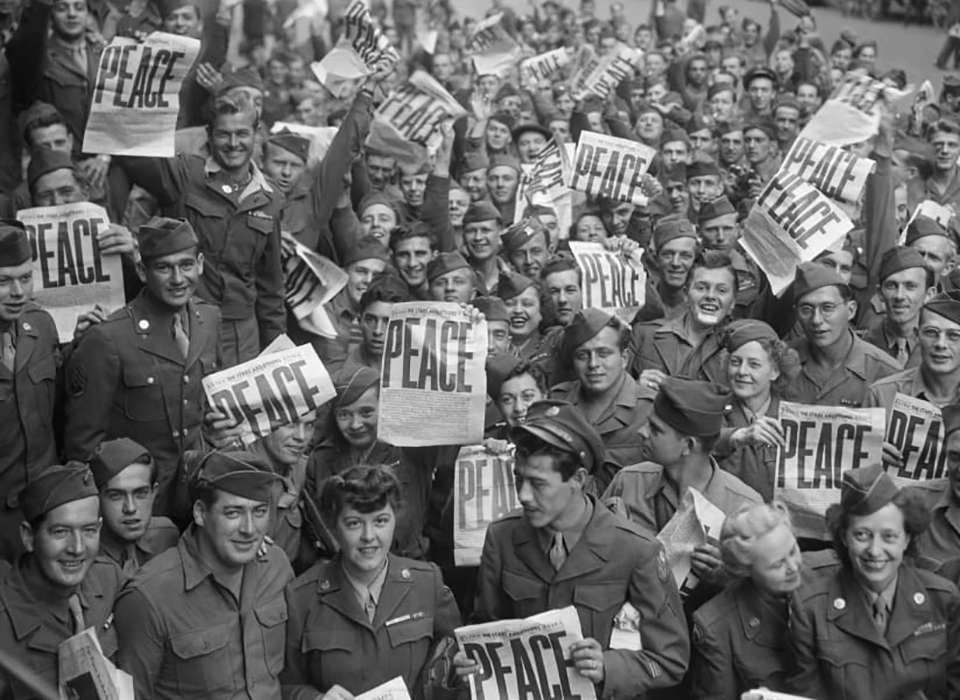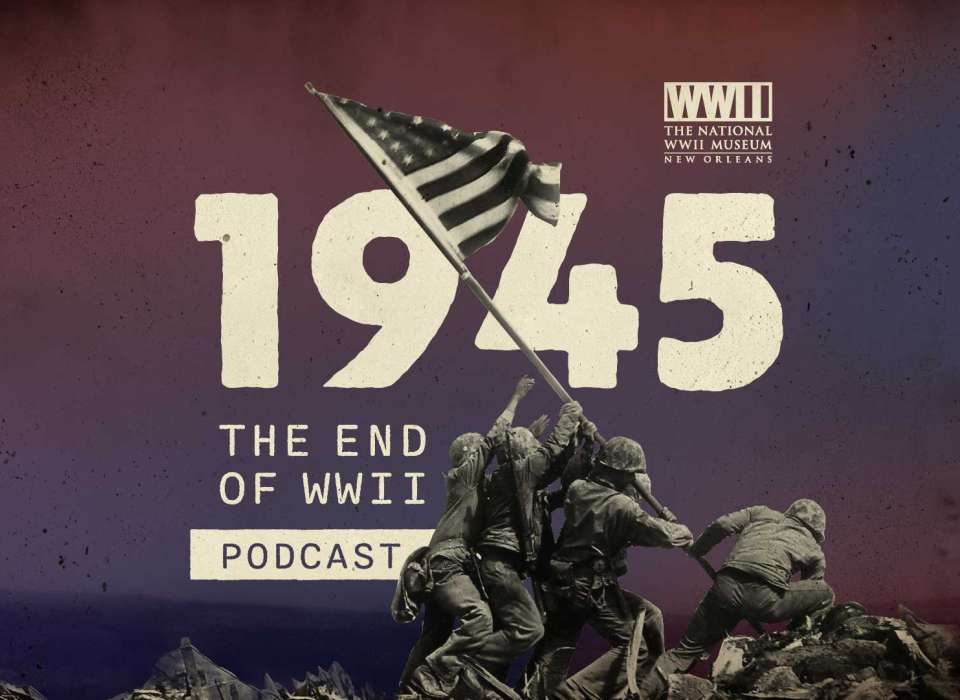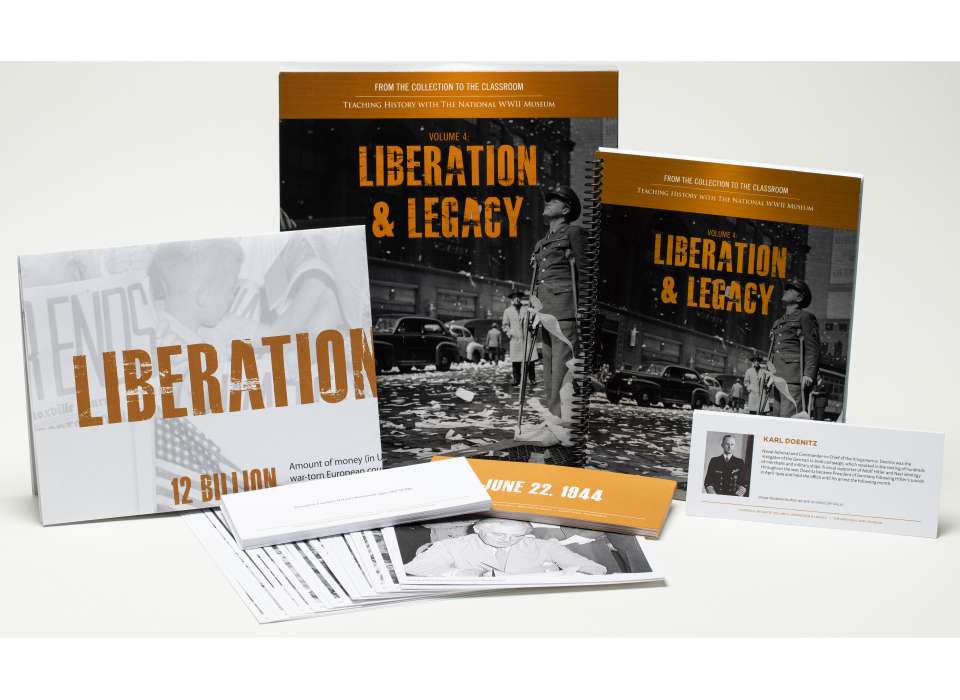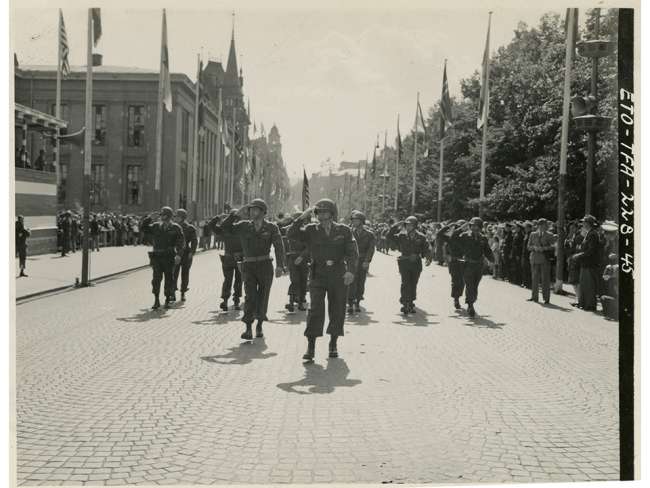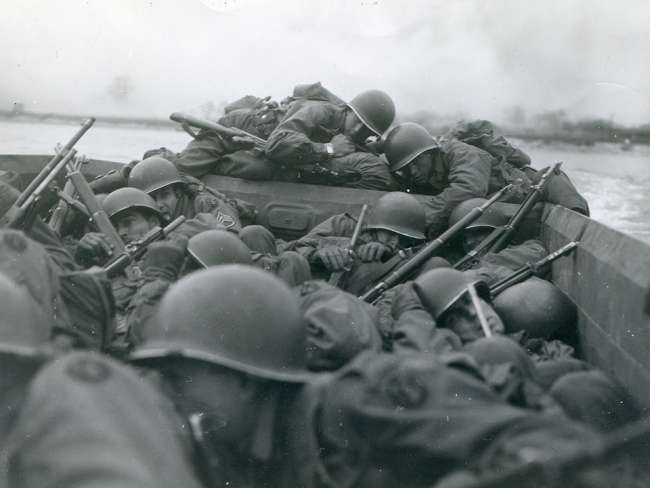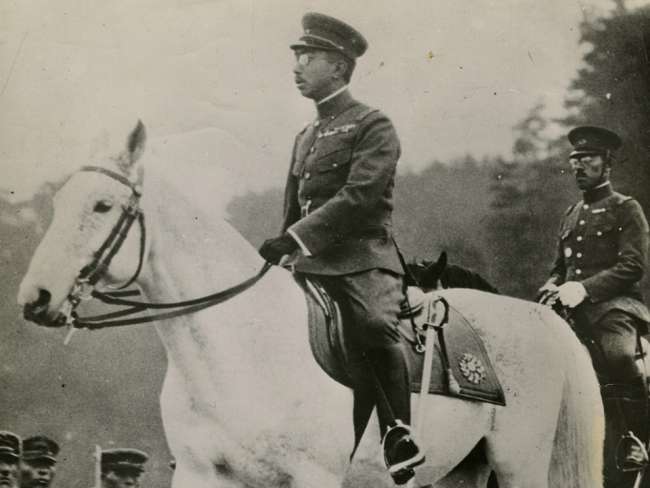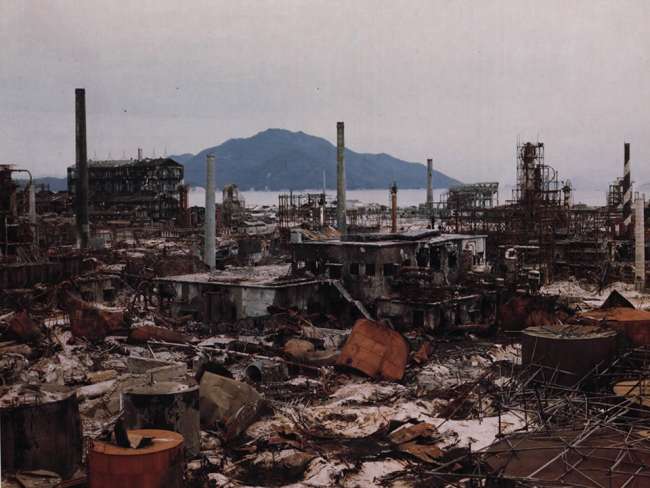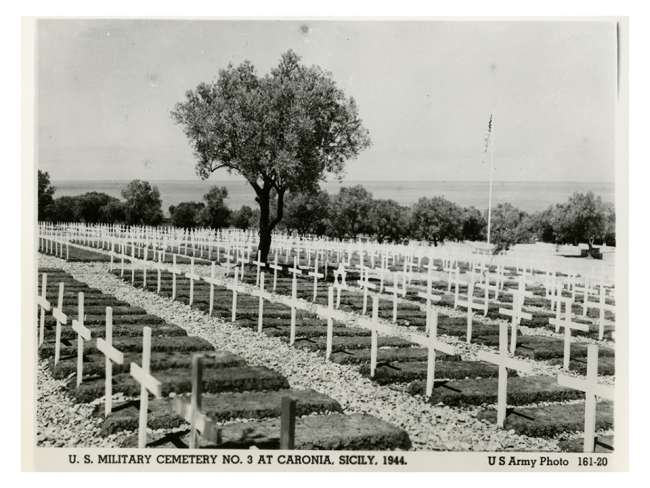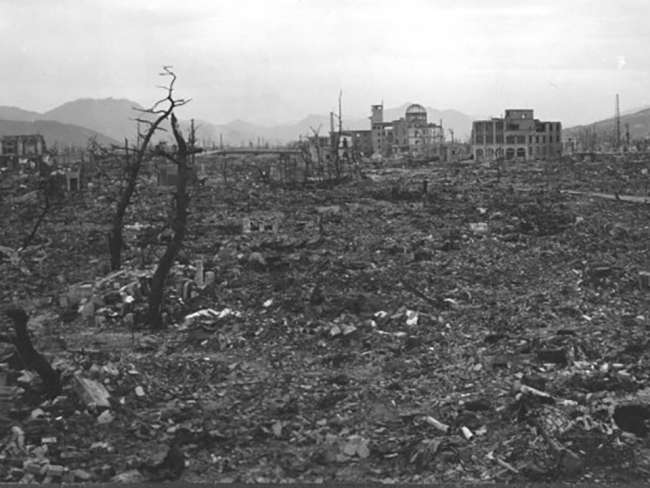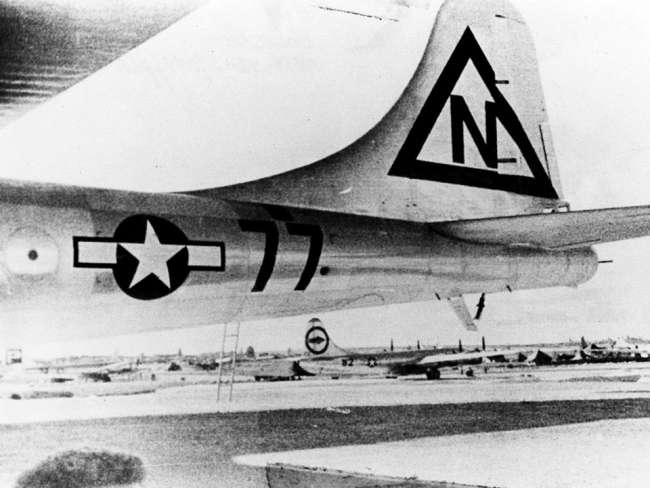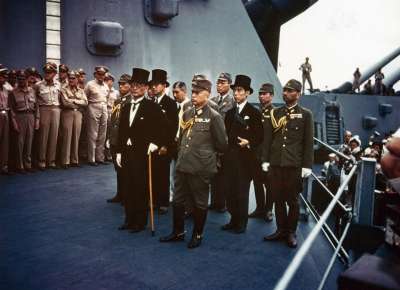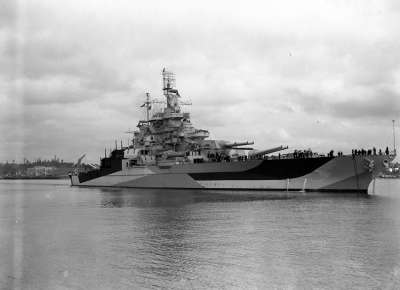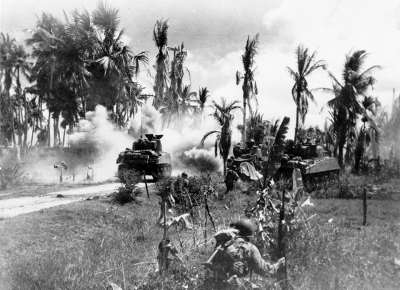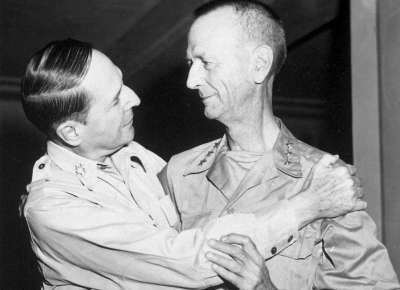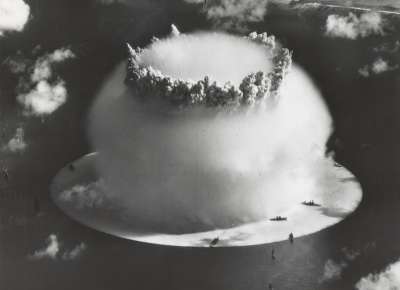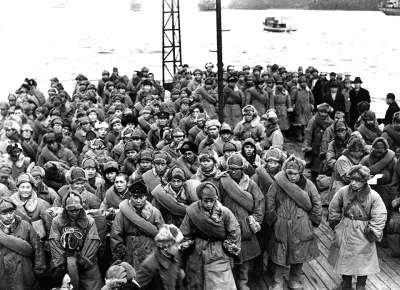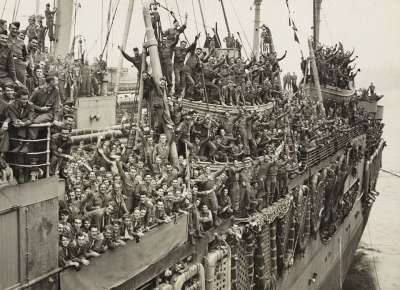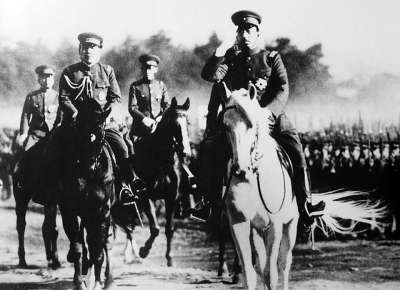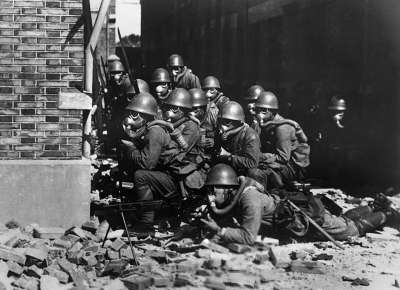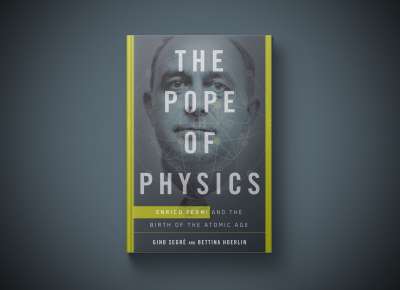Top Photo: American servicemen and women gather in front of "Rainbow Corner" Red Cross club in Paris to celebrate the unconditional surrender of the Japanese. August 15, 1945. National Archives. Records of the Office of the Chief Signal Officer. 111-SC-210241
From July 19 through August 2, 1945, the leaders of the United States, United Kingdom, and Soviet Union met at Potsdam to determine the postwar order and how to administer defeated Germany. During the Potsdam Conference deliberations, Soviet leader Joseph Stalin also agreed that the Soviet Union would enter the war against Imperial Japan 90 days after the German surrender on May 8.
On July 26, American President Harry S. Truman, British Prime Minister Winston Churchill, and Chiang Kai-shek, the leader of the Chinese Nationalist government, issued the Potsdam Declaration, which outlined the surrender terms for Japan. Among the terms, the document called on the government of Japan “to proclaim now the unconditional surrender of all Japanese armed forces” or else face “prompt and utter destruction” by the Allies. In the United States, the absence of any Japanese reply to the Potsdam Declaration was seen as a rejection of Allied terms.
In the Pacific events moved quickly. The United states dropped an atomic bomb on Hiroshima on August 6. Two days later, the Soviet Union declared war on Japan and gave its support to the terms of the Potsdam Declaration. The next day, August 9, the Red Army invaded Manchuria, and a second atomic bomb hit Nagasaki. In Manila, General Douglas MacArthur alerted his commanders to hold their units in readiness for the immediate occupation of Japan and Korea, a plan code-named “Blacklist.”
Liberation and Legacy
While the world cheered the arrival of peace, however, real challenges lay ahead. Industrial age warfare had left scars on the planet that would take years to heal.
On the night of August 9, Japanese Emperor Hirohito met with his cabinet and made the momentous decision to accept the terms of the Potsdam Declaration. Japan’s capitulation would kick off several tense weeks of diplomatic exchanges, ceasefire orders, negotiations, initial occupation operations—and, ultimately, a formal surrender ceremony on September 2, 1945.
Working through the Swiss Government, the Japanese Foreign Ministry on August 10 transmitted to the Allies that Japan would surrender unconditionally. The Foreign Ministry, however, also stipulated their understanding that the declaration in no way “prejudices the prerogatives of His Majesty as a sovereign ruler.”
At Truman’s direction, and on behalf of the Allied governments, US Secretary of State James Byrnes conveyed on August 12 that upon Japan’s surrender, “the authority of the Emperor and the Japanese Government” would be subject to the Supreme Commander of the Allied Powers (SCAP). The United States called on Hirohito to issue orders to all commands to cease fire, end active operations, and transport prisoners of war and civilian internees to places of safety.
On August 14, the Japanese Foreign Ministry accepted those terms, and that evening, Hirohito recorded a radio address announcing the surrender. Japanese officers would try to seize the recording, but the attempted coup collapsed.
Truman announced Japan’s intention to surrender to the American public on August 14 at 7:00 p.m. Washington, D.C., time; not long after, Hirohito’s address was broadcast in Japan at noon local time on August 15. Although the formal surrender ceremony wouldn’t take place until September 2, celebrations erupted across the United States and the globe as World War II was finally brought to an end.
1945
To commemorate the 80th anniversary of the end of World War II, The National WWII Museum presents 1945, a new six-part podcast series that tells the story of one of the most consequential years in modern history.
End of War Classroom Resources
Explore essays, lesson plans, and multimedia resources exploring liberation and the legacy of World War II, connecting events like the Holocaust, the Nuremberg Trials, the Marshall Plan, and the founding of the United Nations to the world of today.
Must Reads
-
Article Type
Liberation and Legacy
Dr. Rob Citino highlights the moments of celebration, as well as realization of the repercussions that followed Allied victory and the end of World War II.
-
Article Type
The Steep Price of Victory in Europe
As the world celebrated victory over Nazi Germany and the boys eventually did come home, the war they fought thousands of miles from American shores came home with them. It came home with them in their wounds, in their memories, in their daily life…in their nightmares.
-
Article Type
"To Bear the Unbearable": Japan's Surrender, Part I
Japanese military leaders debated Japan's possible surrender up to the last moment. Emperor Hirohito's intervention was critical.
-
Article Type
GIs in Germany: First Impressions of the Former Third Reich
By VE-Day, 1.6 million American soldiers stood on German soil. Their first months in the land of their former enemy were marked by a number of surprising observations and interactions.
-
Article Type
"To Bear the Unbearable": Japan's Surrender, Part II
Although a decision to continue the war would mean national suicide, members of the Japanese military came close to refusing Emperor Hirohito’s surrender order.
-
Article Type
Victory for the Lost: The Ultimate Sacrifice That Made V-E Day Possible
Monuments and fields of white crosses mark the cost of victory in Europe. Majestic today, the cemeteries were in a much different state 75 years ago.
-
Article Type
The Most Fearsome Sight: The Atomic Bombing of Hiroshima
On the morning of August 6, 1945, the American B-29 bomber Enola Gay dropped an atomic bomb on the Japanese city of Hiroshima.
-
Article Type
The Bombing of Nagasaki, August 9, 1945
The bombing of the Japanese city of Nagasaki with the Fat Man plutonium bomb device on August 9, 1945, caused terrible human devastation and helped end World War II.
